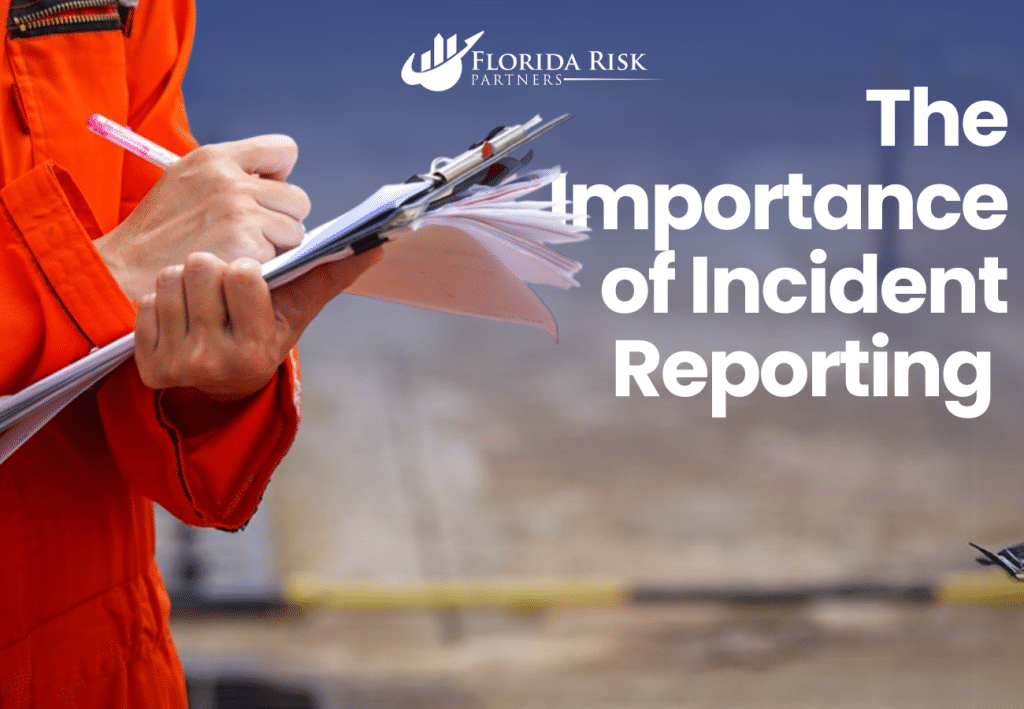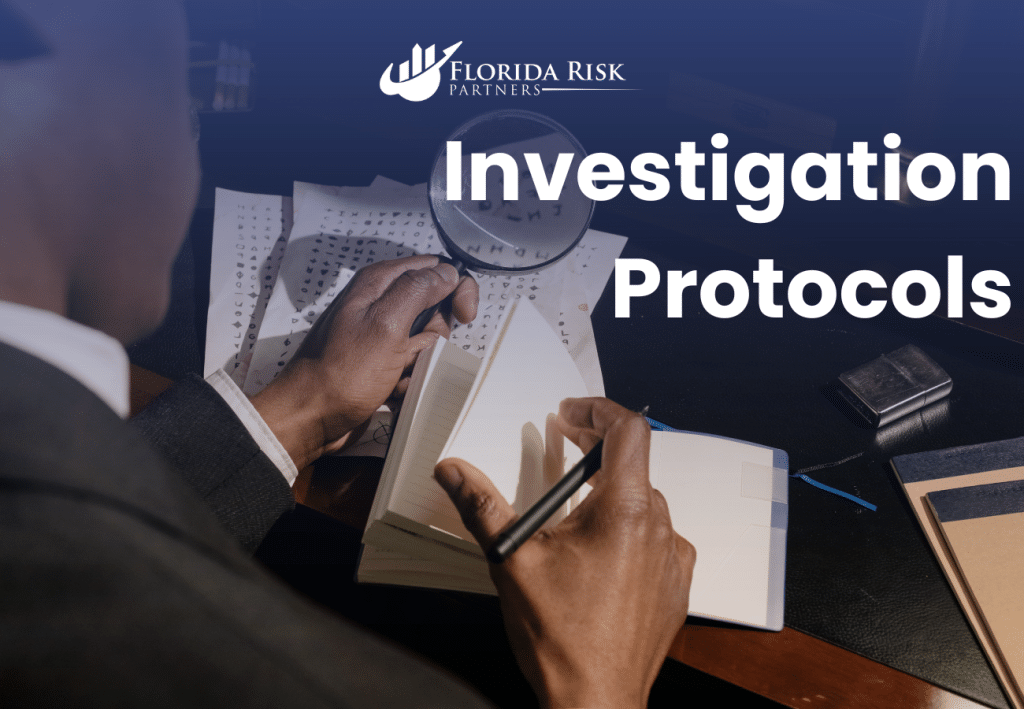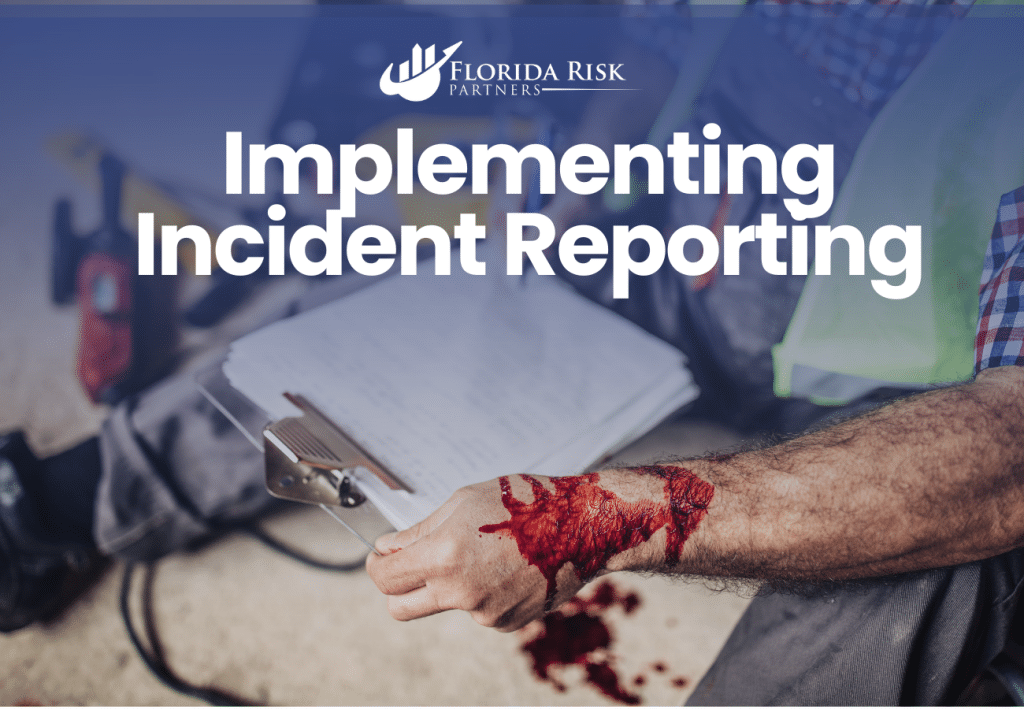-
Main Office: 1434 E. Bloomingdale Ave Valrico, FL 33596-6110
-
Phone: (888) 601-6660
-
Email: info@floridariskpartners.com

In any workplace, incidents such as accidents, near misses, or unsafe conditions can occur despite the best preventive measures. When these events happen, the ability to respond effectively and report them promptly is crucial to maintaining a safe work environment. Incident reporting and response protocols are essential tools that help organizations manage and mitigate the impact of workplace incidents, prevent future occurrences, and ensure compliance with safety regulations.
This blog post will explore the significance of incident reporting and response protocols, the key components of an effective system, and best practices for implementing these protocols in your organization.
Why Incident Reporting and Response Protocols Are Crucial
Incident reporting and response protocols serve multiple purposes in a workplace safety program. Here’s why they are indispensable:
- Prompt Identification of Hazards: Incident reports provide critical information about hazards that may not have been previously identified. This data is essential for taking corrective actions to eliminate or mitigate risks.
- Prevention of Future Incidents: By analyzing incident reports, organizations can identify patterns or trends that may indicate underlying safety issues. Addressing these issues helps prevent similar incidents from occurring in the future.
- Compliance with Regulations: Many industries are governed by strict safety regulations that require the reporting of certain types of incidents. Incident reporting protocols help ensure that organizations meet these regulatory requirements, avoiding potential fines and legal liabilities.
- Enhancing Safety Culture: A robust incident reporting system encourages a culture of transparency and continuous improvement. When employees feel confident that their reports will lead to positive changes, they are more likely to report hazards and participate in safety initiatives.
- Effective Incident Management: Incident response protocols ensure that incidents are managed efficiently and effectively. This includes providing immediate assistance to affected individuals, securing the scene, and conducting thorough investigations to determine root causes.
Key Components of an Effective Incident Reporting and Response Protocol
An effective incident reporting and response protocol should be comprehensive, user-friendly, and designed to encourage prompt and accurate reporting. Here are the key components that should be included:
1. Clear Reporting Procedures
The foundation of any incident reporting protocol is a clear and straightforward reporting procedure. Employees should know exactly how, when, and to whom they should report an incident.
- Simple Reporting Channels: Provide multiple reporting channels, such as online forms, phone hotlines, or direct reporting to supervisors, to make it easy for employees to report incidents.
- Immediate Reporting Requirement: Encourage immediate reporting of all incidents, no matter how minor. Delays in reporting can hinder the investigation process and increase the risk of further harm.
- Documentation Guidelines: Ensure that employees understand what information needs to be documented in an incident report, such as the time, location, and details of the incident, as well as any witnesses or contributing factors.
2. Incident Response Plan
An incident response plan outlines the steps to be taken immediately following an incident. This plan ensures that the situation is managed effectively to minimize harm and prevent further incidents.
- First Aid and Medical Assistance: The response plan should include procedures for providing first aid and seeking medical assistance for injured individuals. This might involve trained first aid personnel on-site or procedures for calling emergency services.
- Securing the Scene: If the incident involves hazardous conditions, the area should be secured to prevent further injuries or damage. This may include isolating the area, shutting down equipment, or removing harmful substances.
- Initial Incident Assessment: Conduct a preliminary assessment to determine the severity of the incident and whether additional emergency response measures are required.
3. Incident Investigation Protocols

Thorough investigations are essential for understanding the root causes of incidents and preventing their recurrence. An incident investigation protocol should guide how investigations are conducted and documented.
- Assigning an Investigator: Designate a qualified individual or team to conduct the investigation. The investigator should be impartial and have the necessary expertise to assess the incident effectively.
- Gathering Evidence: Collect evidence related to the incident, including photographs, witness statements, and any physical evidence at the scene. This documentation is crucial for understanding what happened and why.
- Root Cause Analysis: Use root cause analysis techniques to identify the underlying factors that contributed to the incident. This may involve asking questions such as “What went wrong?” and “Why did this happen?” to dig deeper into the causes.
4. Corrective Actions and Follow-Up
Once the investigation is complete, the next step is to implement corrective actions to address the root causes of the incident. Follow-up is essential to ensure that these actions are effective.
- Developing Corrective Actions: Based on the findings of the investigation, develop specific actions to prevent similar incidents in the future. This might include changes to procedures, additional training, or modifications to equipment.
- Tracking Implementation: Assign responsibility for implementing corrective actions and establish a timeline for completion. Regularly check in on the progress to ensure that the actions are being carried out.
- Effectiveness Evaluation: After corrective actions have been implemented, evaluate their effectiveness. This can be done through safety audits, employee feedback, or monitoring for any recurrence of similar incidents.
5. Communication and Reporting
Effective communication is critical throughout the incident reporting and response process. This ensures that all stakeholders are informed and that lessons learned from the incident are shared across the organization.
- Internal Reporting: Ensure that all relevant parties, including supervisors, safety officers, and management, are informed about the incident and the findings of the investigation.
- External Reporting: If required by regulations, report the incident to external authorities, such as OSHA or industry-specific safety bodies, within the required timeframe.
- Sharing Lessons Learned: Communicate the findings from the investigation and the corrective actions taken to all employees. This helps to reinforce the importance of safety and encourages continuous improvement.
Best Practices for Implementing Incident Reporting and Response Protocols
Implementing effective incident reporting and response protocols requires a proactive approach. Here are some best practices to ensure successful implementation:
1. Foster a Reporting Culture
Encourage employees to report all incidents, including near misses and unsafe conditions. This can be achieved by creating a culture where safety is prioritized, and employees feel comfortable reporting without fear of retaliation.
- Encouraging Reporting: Reinforce the importance of reporting incidents during safety meetings, training sessions, and daily briefings.
- Anonymous Reporting Options: Provide options for anonymous reporting to encourage employees who may be hesitant to report incidents directly.
- Positive Reinforcement: Recognize and reward employees who proactively report incidents and contribute to a safer work environment.
2. Train Employees on Reporting and Response Procedures
Training is essential to ensure that all employees understand the incident reporting and response protocols. Regular training sessions should cover the procedures for reporting incidents, responding to emergencies, and participating in investigations.
- Regular Training Sessions: Conduct regular training sessions for all employees on incident reporting and response procedures. Ensure that new hires receive this training as part of their onboarding process.
- Role-Specific Training: Provide additional training for employees with specific roles in the incident response process, such as first responders, supervisors, and safety officers.

3. Use Technology to Streamline Reporting
Leveraging technology can make incident reporting more efficient and ensure that data is accurately captured and easily accessible for analysis.
- Digital Reporting Tools: Implement digital tools, such as mobile apps or online portals, to allow employees to report incidents quickly and easily from any location.
- Automated Alerts: Use automated systems to alert relevant personnel immediately when an incident is reported, ensuring a swift response.
- Data Analytics: Utilize data analytics tools to analyze incident reports and identify trends or patterns that may indicate broader safety issues.
4. Regularly Review and Update Protocols
Incident reporting and response protocols should be regularly reviewed and updated to reflect changes in the workplace, new regulations, or lessons learned from previous incidents.
- Annual Reviews: Conduct annual reviews of your incident reporting and response protocols to ensure they remain effective and up-to-date.
- Feedback Loop: Establish a feedback loop where employees can provide input on the effectiveness of the protocols and suggest improvements.
Conclusion: Strengthening Workplace Safety Through Incident Reporting and Response
Incident reporting and response protocols are vital components of any effective workplace safety program. They provide a structured approach to managing incidents, from the initial report to the implementation of corrective actions. By fostering a culture of transparency, ensuring timely and accurate reporting, and continuously improving response protocols, organizations can significantly enhance their safety performance and protect their most valuable asset: their employees.
For organizations looking to strengthen their incident reporting and response protocols, the key is to make these processes as straightforward and accessible as possible while ensuring that they are backed by strong leadership commitment and ongoing training. With these elements in place, you can build a safer, more resilient workplace where incidents are not just managed but also prevented.
Call Us Or
Schedule an Appointment
Select an agent below to view our online calendars and select a day and time that works best for you or call us directly at 888-601-6660. When you use our online calendars, you will receive an email with more information.



